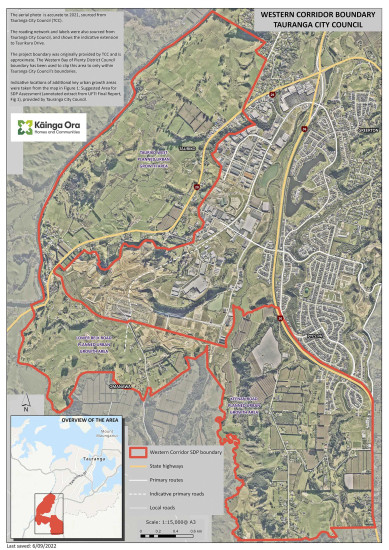New process considered for extensive urban development in Tauranga
15 September 2022
In response to the significant housing need in Tauranga and a request by Tauranga City Council, Kāinga Ora has selected Tauranga’s Western Corridor as the second project for assessment as a potential Specified Development Project under the Urban Development Act 2020.
Selection for assessment kicks off an extensive engagement and consultation process, as Kāinga Ora considers the suitability of using its urban development tools for the project area. Once the assessment process is complete, Kāinga Ora will recommend to Ministers whether or not a Specified Development Project (SDP) should be established.

Proposed project area under assessment.
The western Bay of Plenty sub-region, which includes Tauranga City, has been one of New Zealand’s fastest growing urban areas in recent years. As the population has increased, the demand for housing has exceeded supply, pushing up property prices and increasing the need for new urban development areas.
The SmartGrowth Partnership, which includes the local and regional Councils, tangata whenua and central Government, estimates that an additional 43,000 homes are needed in the region by 2048.
The SmartGrowth partners have identified the Western Corridor as key to meeting this demand and have been looking at how this area can be unlocked for development. Tauranga City Council has now formally requested that Kāinga Ora consider the Western Corridor for selection as a potential SDP under the Urban Development Act 2020.
Tauranga City Council Commissioner, Stephen Selwood, says despite the Western Corridor being identified for urban development through SmartGrowth, the Council has found it difficult to make substantive progress to enable development in the area.
“The size and scale of the planned growth, necessary investment in infrastructure and complexity of structure planning and rezoning under the Resource Management Act 1991 (RMA) has slowed development in the Western Corridor,” he says.
“Tauranga has a significant housing gap and is the only metropolitan area in New Zealand which cannot comply with the housing supply requirements set-out in the Government’s National Policy Statement on Urban Development. The latest projections show that over the next 10 years, the city will be between 7,000 and 9,000 homes short of the number the city needs.
“To deliver housing and urban development at the pace and scale required to meet the needs of our community, it is critical that the planning, infrastructure and funding for urban development are agreed upfront, providing greater certainty and coordination for implementation and delivery.
"A Specified Development Project would provide a process to deliver that integrated planning in the short term, while still allowing the opportunity to future proof the Western Corridor for envisaged growth over the medium and long term."
The proposed project area under assessment includes Tauriko West, Keenan Road and Tauriko Business Estate’s Lower Belk Road extension – three existing urban growth areas which are at various stages of planning and development. Proposals for the wider area include development of new housing and employment areas, an improved transport network, community facilities (including schools) and amenities such as green spaces.
Kāinga Ora General Manager Urban Planning and Design, Katja Lietz, says initial considerations suggest that the Western Corridor could benefit from Kāinga Ora using its urban development tools to facilitate development in the area.
“Specified Development Projects can provide a way for Kāinga Ora to enable transformational, complex urban development,” she says.
“The Western Corridor presents a significant opportunity for the SmartGrowth Partnership, tangata whenua, private developers and landowners to work together to deliver a sustainable, inclusive and thriving community for the people of Tauranga. If established, an SDP can facilitate further collaboration, bringing together a clear development plan aligning land-use planning, infrastructure planning and funding.
“This is one of the fastest-growing regions in the country and our focus during the assessment process will be to determine whether these new urban development tools are the right ones to support a well-planned, high-quality urban development that meets the needs of the community.”
Media Contact
Page updated: 15 September 2022
